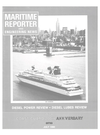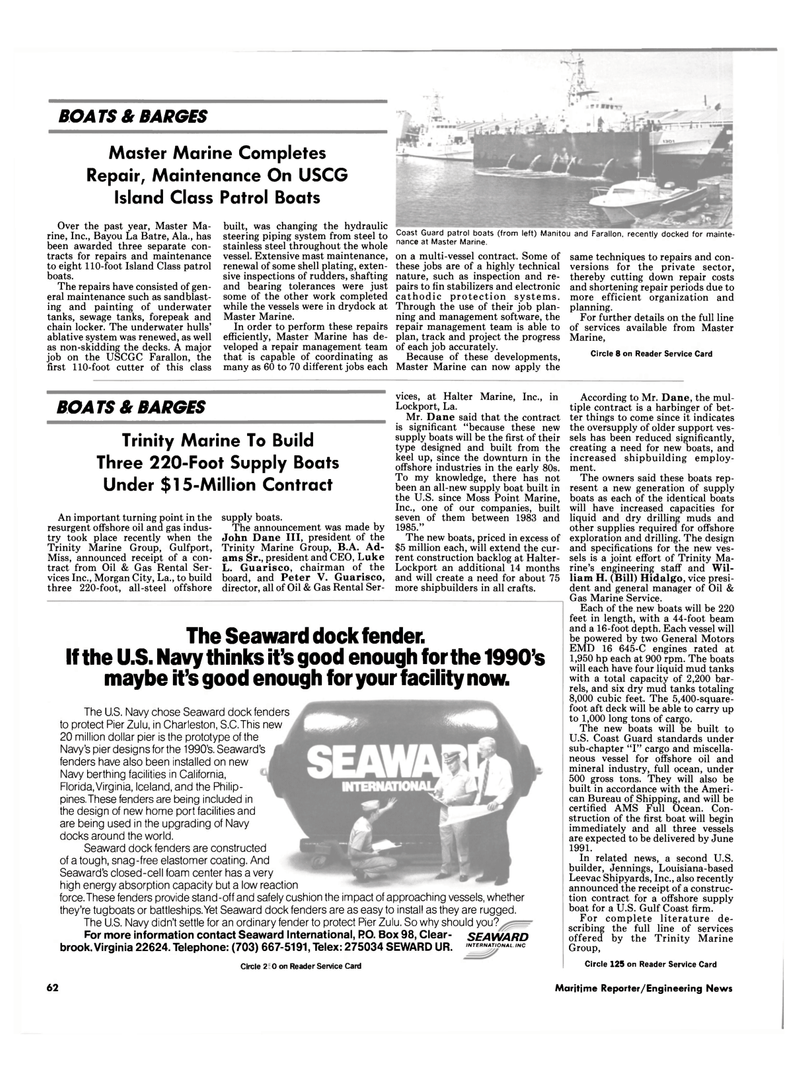
Page 65: of Maritime Reporter Magazine (July 1990)
Read this page in Pdf, Flash or Html5 edition of July 1990 Maritime Reporter Magazine
BOATS & BARGES
Master Marine Completes
Repair, Maintenance On USCG
Island Class Patrol Boats
Over the past year, Master Ma- rine, Inc., Bayou La Batre, Ala., has been awarded three separate con- tracts for repairs and maintenance to eight 110-foot Island Class patrol boats.
The repairs have consisted of gen- eral maintenance such as sandblast- ing and painting of underwater tanks, sewage tanks, forepeak and chain locker. The underwater hulls' ablative system was renewed, as well as non-skidding the decks. A major job on the USCGC Farallon, the first 110-foot cutter of this class built, was changing the hydraulic steering piping system from steel to stainless steel throughout the whole vessel. Extensive mast maintenance, renewal of some shell plating, exten- sive inspections of rudders, shafting and bearing tolerances were just some of the other work completed while the vessels were in drydock at
Master Marine.
In order to perform these repairs efficiently, Master Marine has de- veloped a repair management team that is capable of coordinating as many as 60 to 70 different jobs each on a multi-vessel contract. Some of these jobs are of a highly technical nature, such as inspection and re- pairs to fin stabilizers and electronic cathodic protection systems.
Through the use of their job plan- ning and management software, the repair management team is able to plan, track and project the progress of each job accurately.
Because of these developments,
Master Marine can now apply the same techniques to repairs and con- versions for the private sector, thereby cutting down repair costs and shortening repair periods due to more efficient organization and planning.
For further details on the full line of services available from Master
Marine,
Circle 8 on Reader Service Card
BOATS & BARGES
Trinity Marine To Build
Three 220-Foot Supply Boats
Under $15-Million Contract
An important turning point in the resurgent offshore oil and gas indus- try took place recently when the
Trinity Marine Group, Gulfport,
Miss, announced receipt of a con- tract from Oil & Gas Rental Ser- vices Inc., Morgan City, La., to build three 220-foot, all-steel offshore supply boats.
The announcement was made by
John Dane III, president of the
Trinity Marine Group, B.A. Ad- ams Sr., president and CEO, Luke
L. Guarisco, chairman of the board, and Peter V. Guarisco, director, all of Oil & Gas Rental Ser- vices, at Halter Marine, Inc., in
Lockport, La.
Mr. Dane said that the contract is significant "because these new supply boats will be the first of their type designed and built from the keel up, since the downturn in the offshore industries in the early 80s.
To my knowledge, there has not been an all-new supply boat built in the U.S. since Moss Point Marine,
Inc., one of our companies, built seven of them between 1983 and 1985."
The new boats, priced in excess of $5 million each, will extend the cur- rent construction backlog at Halter-
Lockport an additional 14 months and will create a need for about 75 more shipbuilders in all crafts.
The Seaward dock fender.
If the U.S. Navy thinks it's good enough for the 1990's maybe it's good enough for your facility now.
Circle 201 on Reader Service Card
According to Mr. Dane, the mul- tiple contract is a harbinger of bet- ter things to come since it indicates the oversupply of older support ves- sels has been reduced significantly, creating a need for new boats, and increased shipbuilding employ- ment.
The owners said these boats rep- resent a new generation of supply boats as each of the identical boats will have increased capacities for liquid and dry drilling muds and other supplies required for offshore exploration and drilling. The design and specifications for the new ves- sels is a joint effort of Trinity Ma- rine's engineering staff and Wil- liam H. (Bill) Hidalgo, vice presi- dent and general manager of Oil &
Gas Marine Service.
Each of the new boats will be 220 feet in length, with a 44-foot beam and a 16-foot depth. Each vessel will be powered by two General Motors
EMD 16 645-C engines rated at 1,950 hp each at 900 rpm. The boats will each have four iiquid mud tanks with a total capacity of 2,200 bar- rels, and six dry mud tanks totaling 8,000 cubic feet. The 5,400-square- foot aft deck will be able to carry up to 1,000 long tons of cargo.
The new boats will be built to
U.S. Coast Guard standards under sub-chapter "I" cargo and miscella- neous vessel for offshore oil and mineral industry, full ocean, under 500 gross tons. They will also be built in accordance with the Ameri- can Bureau of Shipping, and will be certified AMS Full Ocean. Con- struction of the first boat will begin immediately and all three vessels are expected to be delivered by June 1991.
In related news, a second U.S. builder, Jennings, Louisiana-based
Leevac Shipyards, Inc., also recently announced the receipt of a construc- tion contract for a offshore supply boat for a U.S. Gulf Coast firm.
For complete literature de- scribing the full line of services offered by the Trinity Marine
Group,
Circle 125 on Reader Service Card
Coast Guard patrol boats (from left) Manitou and Farallon, recently docked for mainte- nance at Master Marine.
The U.S. Navy chose Seaward dock fenders to protect Pier Zulu, in Charleston, S.C.This new 20 million dollar pier is the prototype of the
Navy's pier designs for the 1990's. Seaward's fenders have also been installed on new
Navy berthing facilities in California,
Florida, Virginia, Iceland, and the Philip- pines. These fenders are being included in the design of new home port facilities and are being used in the upgrading of Navy docks around the world.
Seaward dock fenders are constructed of a tough, snag-free elastomer coating. And
Seaward's closed-cell foam center has a very high energy absorption capacity but a low reaction force.These fenders provide stand-off and safely cushion the impact of approaching vessels, whether they're tugboats or battleships. Yet Seaward dock fenders are as easy to install as they are rugged.
The U.S. Navy didn't settle for an ordinary fender to protect Pier Zulu. So why should you?
For more information contact Seaward International, RO. Box 98, Clear- SEAWARD brook. Virginia 22624. Telephone: (703) 667-5191, Telex: 275034 SEWARD UR. INTERNATIONAL. INC 62 Maritime Reporter/Engineering News

 64
64

 66
66
